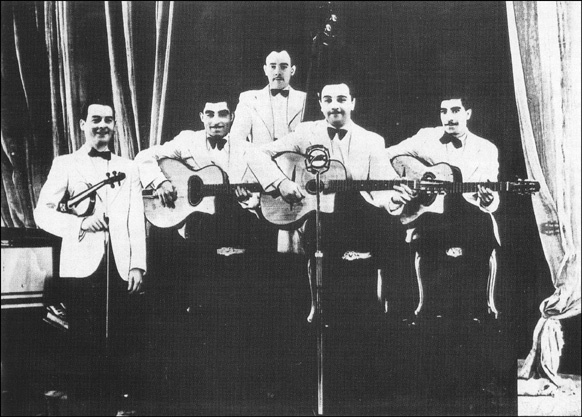
 |
|
#1
|
|||
|
|||
|
I've looked around the web, but so far haven't found a definitive write up regarding the D-hole vs. O-hole designs of Gypsy Jazz Guitars. Anyone here know the scoop on the differences in tone?

|
|
#2
|
|||
|
|||
|
No personal experience with either, but I'd guess the larger D sound hole would allow better low end response relative to the 0 shaped hole.
Thinking of buying one or the other?
__________________
Gibson J-185 (my one and only.) "Knowin' where you're goin' is mostly knowin' where you have been" Buc, from Me & Eddie |
|
#3
|
|||
|
|||
|
Quote:
Sent from my HUAWEI VNS-L31 using Tapatalk |
|
#4
|
|||
|
|||
|
You beat me to it. D'jangobooks is the ultimate Gypsy-Jazz forum. Try googling "Grande bouche vs petite bouche" and you'll get more info.
|
|
#5
|
|||
|
|||
|
Quote:
Maccaferri ended his association with the Selmer company when they wanted to make some production changes to streamline the building process. Maccaferri later emigrated to the United States, where he had great commercial success making and marketing plastic clarinet reeds during WWII, when regular clarinet reeds (made of actual reeds) became scarce. Then sometime in the late 1940's or early 1950's Maccaferri invented the plastic ukulele, which made him a wealthy man. However, he had no further input into the design of Selmer guitars after he left. The "petit bouche" Selmer guitar with the small oval soundhole was Selmer's own in-house development. As soon as it became available Django made the switch, because he preferred its tonal clarity and greater projection. But, as you can see in this photo, his cousins who played rhythm guitars behind him kept playing the Selmer Maccaferri "grande bouche" guitars:  Django Reinhardt and the Quintette of the Hot Club of France That has set the general pattern for gypsy jazz guitar players ever since. The petit bouche gives you more cut and projection, while there's generally more bass response and (probably) more sustain with the grande bouche model. Often when you see more than one guitarist in a gypsy jazz group, the main lead player will be playing a petit bouche Selmer-style guitar while the rhythm guitarist will be comping on chords on a grand bouche Selmer Maccaferri-style guitar. So, basically, rhythm players tend to gravitate to the grande bouche model and lead players tend to use the petit bouche model. Hope that makes sense. Wade Hampton Miller |
|
#6
|
||||
|
||||
|
Great explanation, Wade.
__________________
Bob DeVellis |
|
#7
|
||||
|
||||
|
Petite Bouche traditionally has a longer scale than a Grand Bouche as well. This along with the sound hole size has to do do with their superior cut. Today however, there are hybrid Grand Bouche guitars with longer scales as well. Don't fear the longer scale. Remember that these guitars use lighter gauge strings (.010s or .011s) of a different construction.
__________________
A bunch of nice archtops, flattops, a gypsy & nylon strings… |
|
#8
|
|||
|
|||
|
The Grand Bouche is typically the rhythm guitar and the petite is the soloist but they are used interchangeably as well. My petite bouche is incredibly loud which is characteristic of such guitars. The larger sound hole ones are fuller in tone and more mid to bass range... I need one of those as well

|